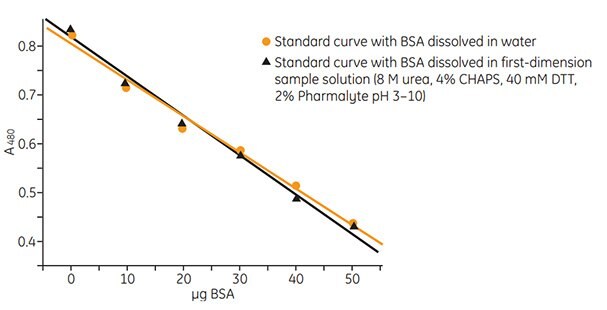Protein Determination using 2-D Quant Kit
2-D Quant Kit is designed to accurately determine protein concentrations in samples for electrophoresis. Proteins are quantitatively precipitated while interfering substances are left in solution. The color density that develops in the 2-D Quant Kit procedure is inversely related to the protein concentration, with a linear response to protein in the range of 0–50 µg and a volume range of 1–50 µL. The procedure is compatible with common sample preparation reagents listed in Table 13.

Figure 15.The 2-D Quant Kit protein assay eliminates interference from sample solution components
Protocol: 2-D Quant Kit
Components supplied
Precipitant, co-precipitant, copper solution, color reagent A, color reagent B, bovine serum albumin (BSA) standard solution.
Required but not provided
Microcentrifuge, microcentrifuge tubes (2 mL), vortex mixer, visible-light spectrophotometer, spectrophotometer cells. Preliminary notes Prior to starting procedure, prepare working color reagent by mixing 100 parts of color reagent A with one part of color reagent B. Each individual assay requires 1 mL working color reagent.
- Prepare standard curve (0–50 µg) using the 2 mg/mL BSA standard solution.
- Prepare microcentrifuge tubes (in duplicate) containing 1–50 µL of the sample to be assayed. The useful range of the assay is 0.5–50 µg.
- Add 500 µL precipitant to each microcentrifuge tube (including tubes containing the BSA standard). Vortex and incubate 2–3 min at room temperature.
- Add 500 µL co-precipitant. Mix briefly.
- Centrifuge (at least 10 000 × g) for 5 min.
- Remove supernatant. Centrifuge briefly to bring remaining supernatant to bottom of tube. Remove remaining supernatant with micropipette.
Proceed rapidly to avoid resuspension or dispersion of pellet. There should be no visible liquid remaining.
- Add 100 µL copper solution and 400 µL distilled or deionized water to each tube. Vortex to dissolve the precipitated protein.
Ensure that the pellet is completely resuspended by vortexing thoroughly.
- Add 1 mL working color reagent to each tube. Ensure instantaneous mixing by introducing the reagent as rapidly as possible.
- Incubate at room temperature for 15–20 min.
- Read the absorbance at 480 nm for each sample and standard using a spectrophotometer such as Ultrospec1100 pro UV/Visible Spectrophotometer.
- Generate standard curve by plotting the absorbance of the standards against the quantity of protein.
- Estimate protein concentration of samples by comparison to the standard curve.
Materials
To continue reading please sign in or create an account.
Don't Have An Account?